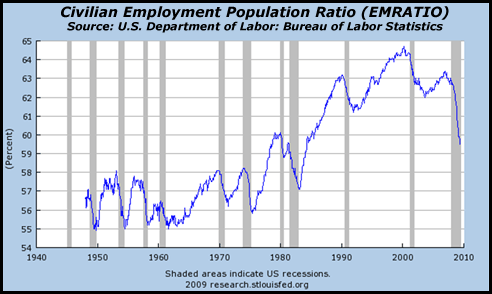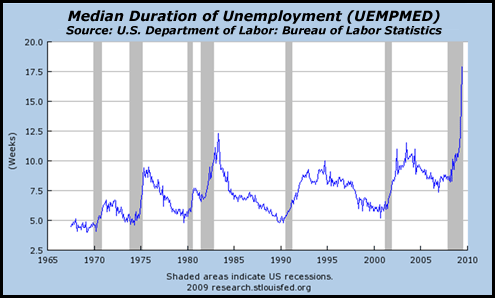Unemployment, Not the Stock Market, Distinguishes a Recession From a Depression
Economics / Great Depression II Jul 08, 2009 - 07:30 AM GMT Claus Vogt writes: What are the most important and enduring characteristics of the Great Depression? And what should we monitor to determine how severe today’s situation really is?
Claus Vogt writes: What are the most important and enduring characteristics of the Great Depression? And what should we monitor to determine how severe today’s situation really is?
The stock market will give important clues. But the economy, especially unemployment, defines depressions.
That should be obvious. However, after the stock market rallied off its March 2009 low, the media and many pundits seem to be fixated on the financial markets to determine the severity of the crisis and to call its end.
To see if the bulls’ hopeful thinking holds water, let’s go back to 1929 and have a look at the stock market’s behavior during those horrific times …
The Bear Market Rally of 1929/30
Yes, there was a spectacular stock market crash in 1929. But a stock market crash does not a depression make. Remember 1987? There was a very similar crash … but no depression. Not even a mild recession.
The crash of 1929 proved to be only the prelude to further heavy losses in 1930-1932. After the initial crash from 381 to 199, a huge rally emerged. Prices rose all the way back to 294 for a 48 percent bear market rally. Hence initial losses were roughly cut in half!
 |
| The stock market crash on Black Thursday, October 24, 1929, was just the beginning of the carnage to hit Wall Street. |
Unfortunately, investors didn’t recognize this rally as a selling opportunity. Instead, they listened to the bullish advice of Wall Street pundits and the government’s declarations that the worst was over and prosperity was right around the corner.
As we all know, this optimism proved to be, well, premature. The huge rally turned out to be just a bear market rally … soon the market started to tank again.
First, stocks tumbled back to the crash-lows, where a second and shallower rally emerged. Then after this bout of hope had evaporated, the market cascaded lower for another two years. From the high during the summer of 1929, the losses mounted to a staggering 89 percent.
Now, let’s fast forward to …
The Bear Market Rally of 2009
After having lost more than 50 percent off its October 2007 high, a huge stock market rally started in March 2009. This rally amounted to 43 percent and had all the typical characteristics of a counter trend move. Especially noteworthy was the low and diminishing volume, which is typical bear market rally behavior.
Just as in 1929, this rally led Wall Street and official sources to conjure economic optimism. This is not a coincidence … the stock market and sentiment measures are highly correlated. But rising sentiment does not forecast a betterment of the economy. Instead a rising stock market foregoes rising optimism.
Now it looks like this bear market rally is over …
There is technical support around 880 in the S&P 500. A break below this mark would ignite another sell signal and confirm the end of the rally. The next support level is around 800. If this line doesn’t hold, it’s back to the March lows. And if these lows do not stop the slide, a very important message concerning the economy will have been given: “Depression ahead.”
I think that the next few weeks and months will not only be very interesting, but also very important. Yet hardly anybody on Wall Street seems to think about the possibility of a new, stock market low.
They should. And so should you. Remember …
Employment Is Much More Predictive Of Recessions and Depressions Than the Stock Market …
Since the start of this crisis, world industrial production and world trade have been following the pattern of the 1930s very closely. But unemployment is the most important indicator to distinguish a recession from a depression.
Year |
Unemployment Rate |
1929 |
3.2% |
1930 |
8.7% |
1931 |
15.9% |
1932 |
23.6% |
1933 |
24.9% |
1934 |
21.7% |
1935 |
20.1% |
1936 |
16.9% |
Take a look at the table on the right to see the unemployment situation during the Great Depression.
Where do we stand now concerning this all important indicator?
The official U.S. unemployment rate rose from the cycle low of 3.4 percent in 2007 to 9.5 percent as of June 2009.
But the Bureau of Labor Statistics computes a second unemployment rate. This broader measure includes all forms of job market slack and is a whopping 16.5 percent. Yes, one in six Americans is unemployed or underemployed right now. That’s a horrible number! And it will not go away soon.
If you look at the chart below, showing the civilian employment to population ratio, you can see that the downtrend had already started in 2000. Then the stock market bubble burst. This was just the first act in a much longer drama …

The bursting of the real estate bubble was act two. And more is sure to follow. California’s default may be a harbinger of what the third act may look like.
The second chart shows the median duration of unemployment. Here you can see how long it takes Americans to find a job …

These statistics clearly show the severity of the current situation. Here you can easily see why this is not a garden variety post-WWII recession, but something very different.
The current plunge is structural, not cyclical. Most of the jobs lost will never come back. The real estate bubble severely distorted the economic structure. Now the world economy has a lot of rebalancing to do. And this process will last much, much longer than the “green shoots” crowd deems possible.
My suggestion for you today is to watch the stock market for hints of the beginning of the next stage of this crisis. Watch unemployment and world trade as reliable indicators of the severity of the slump. And then watch California to get a feel for the next important act of this economic and financial drama: The government funding crisis and all its related repercussions.
Best wishes,
Claus
This investment news is brought to you by Money and Markets . Money and Markets is a free daily investment newsletter from Martin D. Weiss and Weiss Research analysts offering the latest investing news and financial insights for the stock market, including tips and advice on investing in gold, energy and oil. Dr. Weiss is a leader in the fields of investing, interest rates, financial safety and economic forecasting. To view archives or subscribe, visit http://www.moneyandmarkets.com .
Money and Markets Archive |
© 2005-2022 http://www.MarketOracle.co.uk - The Market Oracle is a FREE Daily Financial Markets Analysis & Forecasting online publication.



